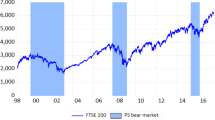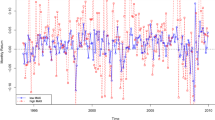Abstract
We build a framework to forecast out-of-sample any asset price movement in a tight window around the release of any macroeconomic indicator. As a case study, we examine the predictability of the EUR/USD exchange rate conditional on the market-based surprise in the first 60 min after the release of the United States Non-Farm Payrolls and ISM manufacturing index. We empirically investigate whether the findings of the literature obtained using an in-sample approach also hold in a real-time out-of-sample exercise. We demonstrate that the main econometric models lose accuracy in an out-of-sample application and cannot outperform a naive model. Additionally, we highlight that the main reason is the counterintuitive direction of a large number of small asset price movements around the release. Finally, we show that clustering the responses to the market-based surprises by their size improves the predictability, reconciling the role given by the literature to nonlinearities.











Similar content being viewed by others
Notes
We select the EUR/USD as our target variable for two main reasons: first, markets are open before and after both ISM and NFP releases, differently for example from the US stock market (e.g., S&P500) which opens at the same time of the NFP release. This feature allows us to proxy for the effect of a macroeconomic release in a short window around the event. Secondly, exchange rates are commonly considered the asset with the strongest correlation with data announcements because they are mostly driven by fundamental factors. See for example Li et al. (2015) which also provide an exhaustive review of the literature on the high-frequency analysis of macro releases on foreign exchange markets.
This characteristic hold even when linearity tests are rejected and nonlinearities appear a highly significant feature of the data. Diebold and Nason (1990) has provided various explanations for this feature. First, nonlinearities can appear in conditional moments of higher orders and be not useful for point prediction. Secondly, the lack of linearity detected by tests may be due to outliers/structural breaks, which are hardly exploited in point forecast. Third, even when appearing in the true data-generating process, nonlinearities in the conditional mean may be too small to improve the point forecast. Fourth, as there are a vast number of nonlinearities, the wrong type of nonlinearity may be considered. Additionally, in the context of exchange rates, Clements and Smith (2001) and Boero and Marrocu (2002, (2004) have shown that using evaluation criteria tailored for point forecasts can heavily penalize nonlinear models, and the entire density forecast should be evaluated.
For example, many forecasters change their ISM forecasts after the regional Federal Reserve Banks communicate their manufacturing surveys, while NFP forecasters usually change their forecasts after the releases of the weekly initial jobless claims report, and the ADP employment report.
In the literature market-based surprises are generally considered martingale difference sequences (see e.g. Rangel 2011).
The price attached to a particular minute is the closing price within the minute. Therefore, the effect of the surprise is embedded in the same minute in which the release is released. Also, we restrict our focus to a 60-min window because empirical works show that the effects of these surprises tend to disappear about 30–45 min after the release. In what follow we also present some evidence of this behavior.
Regarding contemporaneous releases, there are no release that are systematically released contemporaneously to the ISM. Regarding NFP, there are other variables released by the Bureau of Labor Statistics (which also releases the NFP). However, for many of these the Bloomberg survey is short (e.g., average hourly earnings, both month-of-month and year-on-year start after 2010) or is not collected (e.g., underemployment rate). A good candidate would have been the US unemployment rate, which is contemporaneously released with NFP, and for which there is a long series for the Bloomberg survey. However, we tested the predictive power of its market-based surprise on the change in the EUR/USD around the release, and we found no evidence. In particular, without controlling for the NFP surprise (the two are uncorrelated), it has an \(R^2\) as low as 1%. Secondly, conditioning on the NFP surprise, over the 60-min window it significance is scattered. Therefore, we did not include it in the rest of our analysis.
Remember that the signs in Eq. (11) has to be different because positive (negative) surprises are associated with an depreciation (appreciation) of the euro against the dollar.
See Brownlees and Gallo (2006) for a discussion on techniques to clean high-frequency data.
References
Almeida A, Goodhart C, Payne R (1998) The effects of macroeconomic news on high frequency exchange rate behavior. J Financ Quant Anal 33(3):383–408
Altavilla C, Giannone D, Modugno M (2017) Low frequency effects of macroeconomic news on government bond yields. J Monet Econ 92:31–46
Altavilla C, Brugnolini L, Gürkaynak RS, Motto R, Ragusa G (2019) Measuring euro area monetary policy. J Monet Econ 108:162–179
Andersen TG, Bollerslev T, Diebold FX, Vega C (2003) Micro effects of macro announcements: real-time price discovery in foreign exchange. Am Econ Rev 93(1):38–62
Andersen TG, Bollerslev T, Diebold FX, Vega C (2007) Real-time price discovery in global stock, bond and foreign exchange markets. J Int Econ 73(2):251–277
Balduzzi P, Elton EJ, Green TC (2001) Economic news and bond prices: evidence from the us treasury market. J Financ Quant Anal 36(4):523–543
Bernanke BS, Kuttner KN (2005) What explains the stock market’s reaction to federal reserve policy? J Financ 60(3):1221–1257
Boero G, Marrocu E (2002) The performance of non-linear exchange rate models: a forecasting comparison. J Forecast 21(7):513–542
Boero G, Marrocu E (2004) The performance of SETAR models: a regime conditional evaluation of point, interval and density forecasts. Int J Forecast 20(2):305–320
Bollerslev T, Cai J, Song FM (2000) Intraday periodicity, long memory volatility, and macroeconomic announcement effects in the us treasury bond market. J Empir Financ 7(1):37–55
Brownlees C, Gallo G (2006) Financial econometric analysis at ultra-high frequency: data handling concerns. Comput Stat Data Anal 51(4):2232–2245
Clements MP, Smith J (2001) Evaluating forecasts from SETAR models of exchange rates. J Int Money Financ 20(1):133–148
Clements MP, Franses PH, Swanson NR (2004) Forecasting economic and financial time-series with non-linear models. Int J Forecast 20(2):169–183
Diebold FX, Nason JA (1990) Nonparametric exchange rate prediction? J Int Econ 28(3–4):315–332
Ehrmann M, Fratzscher M (2005) Exchange rates and fundamentals: new evidence from real-time data. J Int Money Financ 24(2):317–341
Fair RC (2003) Shock effects on stocks, bonds, and exchange rates. J Int Money Financ 22(3):307–341
Faust J, Rogers JH, Wang S-YB, Wright JH (2007) The high-frequency response of exchange rates and interest rates to macroeconomic announcements. J Monet Econ 54(4):1051–1068
Fleming MJ, Remolona EM (1999) Price formation and liquidity in the us treasury market: the response to public information. J Financ 54(5):1901–1915
Galati G, Ho C (2003) Macroeconomic news and the euro/dollar exchange rate. Econ Notes 32(3):371–398
Gürkaynak RS, Sack B, Swanson ET (2005a) Do actions speak louder than words? The response of asset prices to monetary policy actions and statements. Int J Cent Bank 1(1):55–94
Gürkaynak RS, Sack B, Swanson ET (2005b) The sensitivity of long-term interest rates to economic news: evidence and implications for macroeconomic models. Am Econ Rev 95(1):425–436
Gürkaynak RS, Kısacıkoğlu B, Wright JH (2018) Missing events in event studies: identifying the effects of partially-measured news surprises. NBER Working Paper, No. 25016
Inoue A, Jin L, Rossi B (2017) Rolling window selection for out-of-sample forecasting with time-varying parameters. J Econom 196(1):55–67
Jarociński M, Karadi P (2020) Deconstructing monetary policy surprises-the role of information shocks. Am Econ J Macroecon 12(2):1–43
Kuttner KN (2001) Monetary policy surprises and interest rates: Evidence from the fed funds futures market. J Monet Econ 47(3):523–544
Li W, Wong MC, Cenev J (2015) High frequency analysis of macro news releases on the foreign exchange market: a survey of literature. Big Data Res 2(1):33–48 (Special Issue on Computation, Business, and Health Science)
Molodtsova T, Papell DH (2009) Out-of-sample exchange rate predictability with Taylor rule fundamentals. J Int Econ 77(2):167–180
Nakamura E, Steinsson J (2018) High-frequency identification of monetary non-neutrality: the information effect. Q J Econ 133(3):1283–1330
Pericoli M, Veronese G (2015) Forecaster heterogeneity, surprises and financial markets. Bank of Italy, Working Paper 1020
Rangel JG (2011) Macroeconomic news, announcements, and stock market jump intensity dynamics. J Bank Financ 35(5):1263–1276
Roache SK, Rossi M (2010) The effects of economic news on commodity prices. Q Rev Econ Financ 50(3):377–385
Robinson PM (1989) Nonparametric estimation of time-varying Parameters. In: Hackl P (ed) Statistical analysis and forecasting of economic structural change. Springer, Berlin, Heidelberg
Scotti C (2016) Surprise and uncertainty indexes: real-time aggregation of real-activity macro-surprises. J Monet Econ 82(C):1–19
Swanson ET, Williams JC (2014) Measuring the effect of the zero lower bound on medium-and longer-term interest rates. Am Econ Rev 104(10):3154–85
Author information
Authors and Affiliations
Corresponding author
Additional information
Publisher's Note
Springer Nature remains neutral with regard to jurisdictional claims in published maps and institutional affiliations.
Without implications, we would like to thank Stefano Neri, Roberta Zizza, the editor and two anonymous referees for their useful suggestions. The views and the opinions expressed in this paper are those of the authors and do not necessarily reflect those of the Bank of Italy and/or the Eurosystem. All errors remain ours. The study did not receive funding, and the authors declare that they have no conflict of interest. All data sources are reported in the text, and codes are available from the authors upon request.
Appendix: Filtering Procedure
Appendix: Filtering Procedure
We clean the high-frequency data to eliminate observations not reflecting market activities. Removal of miss-quotes is crucial as they can compromise the computation of surprises.Footnote 9 We implemented the following procedure (this is similar to the one also adopted in cleaning the high-frequency data in Altavilla et al. 2019)
-
1.
Deleting entries for which the Bid-Ask spread is negative.
-
2.
Deleting entries five times greater than the full-time series standard deviation.
-
3.
Deleting entries for which the Bid and Ask are more than 5 times the standard deviation of the month.
-
4.
Deleting entries for which the Bid and Ask are more than 5 times the standard deviation of the day.
-
5.
Deleting entries for which the Bid-Ask spread is more than 50 times the median spread on that day.
After cleaning, tick data are discretized to a minute-frequency. We discretize assigning the last tick in a minute and carry forward the last observation when no-transactions within a minute are made. The quote we use is the median of this cleaned, discretized data.
Rights and permissions
About this article
Cite this article
Brugnolini, L., D’Agostino, A. & Tagliabracci, A. Is Anything Predictable in Market-Based Surprises?. Ital Econ J 7, 387–410 (2021). https://doi.org/10.1007/s40797-020-00134-z
Received:
Accepted:
Published:
Issue Date:
DOI: https://doi.org/10.1007/s40797-020-00134-z




